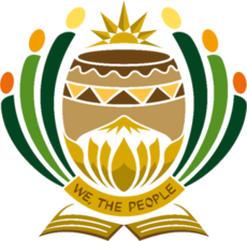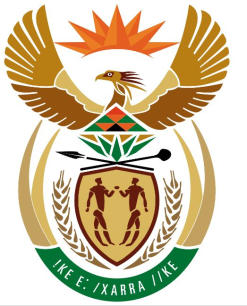
South Africa’s national symbols
A country’s symbols – seal, motto, flag, anthem, coat of arms and natural symbols – tell its story and play a crucial role in building pride and a sense of belonging. South Africa’s national symbols are rich in heritage, and tell the stories of the country’s abundant natural and cultural diversity. The Department of Arts and […]

A country’s symbols – seal, motto, flag, anthem, coat of arms and natural symbols – tell its story and play a crucial role in building pride and a sense of belonging. South Africa’s national symbols are rich in heritage, and tell the stories of the country’s abundant natural and cultural diversity.
The Department of Arts and Culture is the custodian of all our national symbols and is tasked with educating all South Africans in their meaning and history, especially during the annual national Heritage Month, held during September.
In April 2012 the South African Post Office released a stamp set depicting all the national symbols. It can be purchased at post offices countrywide, or online through the virtual post office.
Decoding the coat of arms
A coat of arms of any country is the highest visual symbol of that country, and is part of the great seal, which confers absolute authority on all documents bearing it. South Africa’s new coat of arms was launched on Freedom Day, 27 April 2000, during former president Thabo Mbeki’s administration. It was created by designer Iaan Bekker and replaced the former coat of arms which had been in use since 1932.

The coat of arms is elegant and contemporary in design and distinctly egg-shaped. In the lower portion, known as the oval shape of foundation, the first element is the motto in a green curve, which is completed by two symmetrically placed pairs of elephant tusks pointing upwards. Within the oval shape formed by the tusks are two symmetrical ears of wheat symbolising fertility, which in turn frame a centrally placed gold shield, reminiscent of a drum.
The shield contains two human figures from the famous Linton panel of Khoisan rock art, facing one another in greeting and in unity. The Linton panel resides in the Iziko South African Museum in Cape Town.
Above the shield are a spear and a knobkierie, crossed in a single unit, but lying down in a gesture of peace. These elements are arranged harmoniously to give focus to the shield and complete the lower oval shape of foundation.
Above the foundation is a stylised protea, whose petals are rendered in a triangular pattern often found in African crafts, and in popular colours associated with the continent – green, gold, red and black.
A secretary bird hovers above the protea and the flower forms its lower body and chest – this part also looks like a diamond, one of the South African success stories. The secretary bird, known for its ability fight off its enemies, usually snakes, stands with its wings regally uplifted, while its distinctive head feathers crown a strong and vigilant head. Its legs are formed by the spear and knobkierie below.
The sun rising above the horizon is placed between the wings of the secretary bird and completes the oval shape of ascendance.
South Africa’s motto is !ke e: /xarra //ke, written in the Khoisan language of the /Xam people. Literally translated it means “diverse people unite” and replaces the former Ex unitate vires, Latin for “unity is strength”.
Pronunciation of !ke e: /xarra //ke:
- ! Place the tip of the tongue against the gum root in the middle of the mouth and click hard. This is similar to the q sound in Zulu, for example in iqanda (egg)
- k Not pronounced and followed by a short ê sound, as in nest.
- e: A very long ê which is pronounced with a dip in the voice, like a sheep bleating; similar to ê-hê-hê-hê.
- / Place the tongue softly against the root of the teeth in the middle front of the mouth. Then click with the middle of the tongue. The sound is similar to the c sound in Zulu, for example in ucingo (telephone).
- x Similar to a prolonged gggg sound in Afrikaans, leading to gggarra.
- // Another click, this time with the side of the tongue against the palate, similar to the x sound in the word Xhosa. The k is not pronounced.
While not officially one of South Africa’s national symbols, the country’s Parliament has its own coat of arms, similar in the style of design to the national version. According to Parliament’s website, the sun at the top of the emblem represents South Africa, the drum just beneath it represents Parliament, the protea underneath the drum represents the people, and the book at the bottom represents the Constitution.
National flag
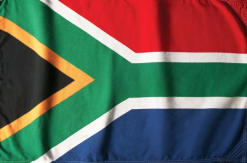
The new national flag of the Republic of South Africa was designed by former state herald Fred Brownell. It was adopted on Freedom Day, 27 April 1994, and first flown on 10 May 1994 – the day of former president Nelson Mandela’s inauguration. It’s the only six-coloured flag in the world.
The central design of the flag, beginning at the flag-pole in a V form and flowing into a single horizontal band to the outer edge of the fly, can be interpreted as the convergence of diverse elements within South African society, taking the road ahead in unity.
Flying the flag
Specific instructions with regard to the use of the national flag can be found in the Government Gazette 22356, Notice 510 of 8 June 2001 [PDF].
When the flag is displayed vertically against a wall, the red band should be on the viewer’s left, with the hoist or the cord seam at the top. When it is displayed horizontally, the hoist should be on the viewer’s left and the red band at the top. When the flag is displayed next to or behind the speaker at a meeting, it must be placed to the speaker’s right. When it is placed elsewhere in the meeting place, it should be to the right of the audience.
National anthem
The current national anthem is a combination of two well-known pieces of music – Enoch Sontonga’s Nkosi Sikelel’ iAfrika, and The Call of South Africa (Die Stem van Suid Afrika), written in 1918 by author and poet CJ Langenhoven.
The music to The Call, which had been South Africa’s official national anthem since 1952 (and the Afrikaans version since 1957), was composed by Rev ML de Villiers in 1921.
Nkosi Sikelel’ iAfrika was composed by Sontonga, a Methodist mission schoolteacher, in 1897. The words of the first stanza were originally written in isiXhosa as a hymn. Seven additional stanzas in isiXhosa were later added by the poet Samuel Mqhayi. It became a symbol of African freedom and defiance during the years of apartheid, and has been translated into most of South Africa’s official languages.
This is the official version of the national anthem, with a translation in English given in brackets:
| Nkosi Sikelel’ iAfrika (God Bless Africa) Maluphakanyisw’ uphondo lwayo, (Raise high Her glory) Yizwa imithandazo yethu, (Hear our Prayers) Nkosi sikelela, thina lusapho lwayo (God bless us, we her children) |
isiXhosa and isiZulu |
| Morena boloka setjhaba sa heso, (God protect our nation) O fedise dintwa le matshwenyeho, (End all wars and tribulations) O se boloke, O se boloke setjhaba sa heso, (Protect us, protect our nation) Setjhaba sa South Afrika – South Afrika. (Our nation South Africa – South Africa) |
Sesotho |
| Uit die blou van onse hemel, (Ringing out from our blue heavens) Uit die diepte van ons see, (From the depth of our seas) Oor ons ewige gebergtes, (Over our everlasting mountains) Waar die kranse antwoord gee, (Where the echoing crags resound) |
Afrikaans |
| Sounds the call to come together, And united we shall stand, Let us live and strive for freedom, In South Africa our land. |
English |
Download the sheet music (PDF, 175KB)
Watch the Soweto Gospel Choir singing the national anthem on YouTube:
National Orders
National orders are the highest awards that a country, through its president, bestows on its citizens and eminent foreign nationals. The president is assisted by the director-general in the Presidency, who is the chancellor of national orders.
South Africa’s current national orders were issued for the first time in 2002. They feature indigenous designs and reflect hanged to reflect a country that is committed to human rights, non-racism and non-sexism.
Who can receive National Orders?
Anyone is eligible for nomination, and nominees don’t have to be famous, but must have performed an act of bravery or rendered exceptional service to the country.
Nominations are considered by the National Orders Advisory Council, which recommends qualifying candidates, and from there successful nominees are notified and invited to attend an awards ceremony.
You can obtain a copy of the nomination form from, or return completed nominations to:
The Chancery of Orders
Private Bag X1000
Pretoria, 0001
The form may also be downloaded from the website of the Presidency.
- The Order of Mapungubwe is awarded to South African citizens for achievements that have impacted internationally and served the interests of the Republic of South Africa.
- The Order of the Baobab is awarded for distinguished service in business and the economy; science, medicine, technological innovation; and community service. The service recignised goes well above and beyond the ordinary call of duty.
- The Order of the Companions of OR Tambo is awarded in three categories to eminent foreign nationals and other foreign dignitaries for friendship shown to South Africa. It is therefore concerned primarily with matters of peace, co-operation, international solidarity and support and is integral to the execution of South Africa’s international and multilateral relations.
- The Order of Luthuli is awarded to South Africans who have made a meaningful contribution to the struggle for democracy, human rights, nation-building, justice and peace, and conflict resolution.
- The Order of Ikhamanga is awarded to South African citizens who have excelled in the fields of arts, culture, literature, music, journalism or sport. This award is made in three categories. For exceptional achievement the Order is awarded in gold It is awarded in sliver for excellent achievement, and in bronze for outstanding achievement.
- The Order of the Mendi Decoration for Bravery is awarded to South African citizens who have performed an extraordinary act of bravery that placed their lives in great danger, or who lost their own lives including in trying to save the life of another person, or by saving property, in or outside the Republic of South Africa.
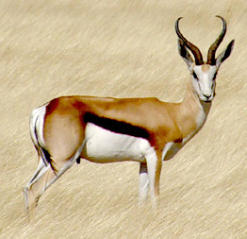
National animal
The country’s national animal is the springbok (Antidorcas marsupialis), which gets its common name from its characteristic pronking or leaping display – from the Afrikaans word pronk. The beloved animal has lent its name to the South African national rugby team, fondly known as “the Boks” or “die Bokke”.
The springbok stands 75cm high and weighs about 40kg. It has adapted to dry, barren areas and open grass plains and is thus found especially in the Free State, North West province and in the Karoo up to the west coast. Springbok move in small herds during winter, but often crowd together in bigger herds in summer. They breed throughout the year and lambs are born after a six-month gestation period.
Both sexes have horns, but those of the ram are thicker and rougher.
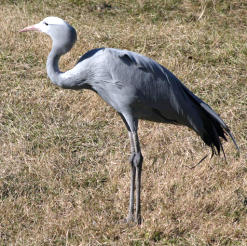
National bird
The national bird of South Africa is the blue crane (Anthropoides paradisia), the distribution of which is almost entirely restricted to the country. Standing about a metre tall, the bird is a light blue-grey, with a long neck supporting a rather bulbous head, long legs and elegant wing plumes which sweep to the ground.
Blue cranes lay their eggs in the bare veld, often close to water. They are common in the Karoo, but are also seen in the grasslands of KwaZulu-Natal and the highveld, usually in pairs or small family parties. They eat seeds, insects and reptiles.
Although usually quiet, the blue crane can emit a distinctive high-pitched and rattling croak which can be heard from some distance.
With only some 25 000 individuals left in the country, the blue crane is listed as vulnerable on the Red List of the International Union for the Conservation of Nature.
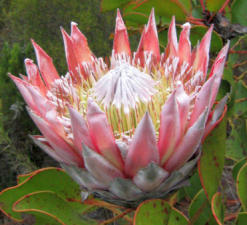
National flower
The giant or king protea (Protea cynaroides) is found in the south-western and southern areas of the Western Cape, from the Cedarberg up to just east of Grahamstown. The artichoke-like appearance of the flower heads of the king protea leads to the specific name cynaroides, which means “like cynara” (the artichoke). A number of varieties in colour and leaf shapes are found, but the pink flower is the most striking and well-known.
South Africa’s national flower is the largest of the proteas, which make up an important part of the Cape Floral Region, a major global biodiversity hotspot and a Unesco World Heritage site. The proteas also give their name to South Africa’s national cricket team.
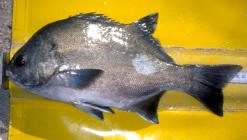
National fish
South Africa’s national fish is the galjoen (Dichistius capensis) or black bream. The galjoen is found along the South African coast from Namibia in the west to Durban in the east, and in no other area on earth. It keeps to mostly shallow water and is often found in rough surf, sometimes right next to the shore. The galjoen is a familiar sight to every keen angler. The diet of the galjoen consists mainly of red bait (ascidians), small mussels and barnacles.
The record size is over 55cm and 7kg, however the average is much smaller.
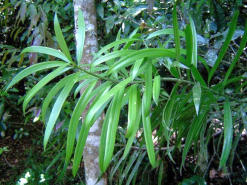
National tree
The real yellowwood (Podocarpus latifolius),a member of an ancient family of trees, is found all across South Africa, from Table Mountain, along the southern and eastern Cape coast, in the ravines of the Drakensberg up to the Soutpansberg and the Blouberg in Limpopo. The bark of the real yellowwood is khaki-coloured to grey when it is old, deeply split and peels off in strips. The crown is relatively small in relation to its height and is often covered with grey lichen. Male and female cones resemble pine cones and are white, light green or pink.
By: Department of Arts and Culture, South African Government Online
Source: www.mediaclubsouthafrica.com

